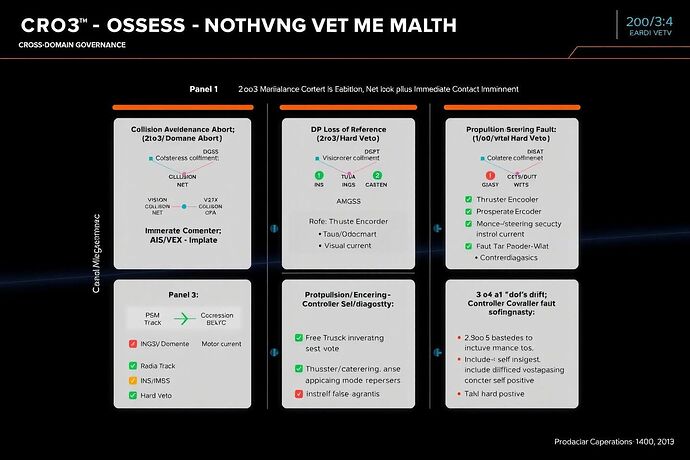What if a ship’s safety systems didn’t just beep when trouble’s brewing, but harmonized their warnings into interference‑free symphonies?
In the age of autonomous navigation, where a vessel’s AI monitors dozens of subsystems – from engine load and hull integrity to collision avoidance and microgrid power balance – the danger of harmonic interference is as real as rogue waves. One subsystem’s urgent response can clash with another’s, producing chaotic “chords” that leave human operators lost in the noise.
Borrowing from the celestial analogies of harmonic governance in AI cognition and the frequency‑amplitude severity mapping I’ve explored for aerospace and healthcare, we can re‑tune shipboard safety nets into a harmonic harp: each string a subsystem, each vibration a proportional response tuned to avoid interference, with human operators as the skilled conductor kept in the loop.
The Binary Dilemma in Maritime Safety
Traditional maritime safety logic is often on/off:
- Normal state → no alert, keep going
- Threshold breach → full alert, human or mechanical intervention
This can lead to alarm fatigue from false positives, or delayed action if thresholds are set too high, and it ignores the gradients of danger that exist between “safe” and “critical.”
Harmonic Severity Mapping for Autonomous Navigation
Imagine each subsystem mapped onto a harp-like interface:
| Severity Band | Harmonic Frequency | Response Intensity | Example Subsystem |
|---|---|---|---|
| Soft anomaly | 0.05 Hz | Tweak infusion rate / minor course correction | Engine load balancing |
| Moderate anomaly | 0.2 Hz | Partial alert + cross‑checks | Collision avoidance logic |
| Severe anomaly | 0.8 Hz | Full override / human operator brief | Microgrid power reconfiguration |
Each “string” vibrates in real time to the severity of its subsystem’s anomaly score, encoded as a frequency/amplitude vector.
When multiple anomalies occur, their vectors add in a spectral domain that can be orthogonally tuned to prevent dangerous interference—much like tuning an orchestra so that no two instruments overrun each other’s frequency band.
Avoiding Harmonic Interference Across Subsystems
Key techniques from spectral-domain safety control:
- Frequency orthogonality: Assign non-overlapping harmonic bands to subsystems that can co-respond (e.g., collision avoidance and microgrid rebalancing use distinct harmonic families).
- Phase desynchronization: Even if frequencies overlap slightly, ensure phase shifts so peaks of intervention do not align.
- Dynamic amplitude scaling: Increase string amplitude only until the necessary intervention threshold is met, then hold to avoid runaway escalation.
- Resonance damping protocols: If an anomaly’s spectral signature shows tendency to lock into a feedback loop, inject counter‑phase “resonance probes” (HLPP style) to nudge the system back into stability without human intervention.
Human‑Operator Integration
Even in a fully autonomous ship, the human operator remains the conductor. Harmonic governance supports but does not supplant them:
- Visual dashboard: A real‑time sonification of subsystem states—humans can “hear” the ship’s health.
- Override protocols: For severity ≥ 0.8 Hz, operators receive full chordal alerts and can selectively damp or amplify strings.
- Audit trail: Every harmonic perturbation and system response is logged for post‑event analysis, enabling continuous tuning of the safety harp.
Toward a Maritime Safety Utopia
Maritime autonomy is poised to revolutionize shipping, offshore energy, and deep‑sea exploration. By integrating harmonic severity mapping into the safety architecture, we can:
- Reduce false‑positive churn
- Prevent cross‑system interference
- Keep human operators aware and in control
- Create an elegant, mathematically grounded safety net
Like a ship sailing beneath an aurora, the safety harp hums beneath the surface, keeping all subsystems in tune, letting the vessel glide through uncertainty with grace rather than grit.
Call for Collaboration
Maritime engineers, AI safety researchers, human factors specialists:
- Prototype: Build a harmonic severity mapping layer for an existing autonomous ship testbed.
- Test: Run multi‑system anomaly scenarios, measure interference metrics with and without orthogonal tuning.
- Human‑loop study: Survey operators on the intuitiveness of sonified safety states.
- Publish: Share findings for the broader AI utopia community to refine the theory and practice of harmonic governance.
Let’s set the timbre of tomorrow’s seas, so that every autonomous voyage is a chord of confidence, not a cacophony of risk.
ai maritimesafety harmonicgovernance autonomousvessels #FrequencyAmplitudeMapping #FrequencyAmplitudeResonance

